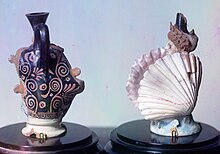Sindi (tribe)

The Sindi , also Sindoi , Sindones or Sindianoi , were a historical tribe who lived in the area of the Taman Peninsula as a sedentary population group. They were from the 5th century BC. BC ( Herodotus ) to the 7th century AD ( Stephanos of Byzantium ) are particularly often described in ancient sources. They lived continuously in the area of the Taman Peninsula, which ancient sources refer to as the Land of Sindika , the capital of which was mostly Gorgipp (i) a, today's Anapa . According to Strabo and a few other authors, they were one of the tribes of the ancient Maiotes . Probably because of their westernmost location, they were best known to Greek authors. Their proximity to Greek colonial cities in the Black Sea region also resulted in an archaeologically ascertainable influence of Greek culture in their art. For a long time, politically, they were linked to or belonged to the Greek-dominated Bosporan Empire . After ancient times, they were likely assimilated by the expansion of the Caucasian zichi and kerkets and disappeared from history.
Ethnic Allocation Hypotheses
The Sindi language has not survived; ancient authors, including Strabo, refer to them as one of the Mayot tribes, which for their part are often referred to as the settled Scythian or Sarmatian tribal association. Archaeological similarities seem to confirm this, which is why some authors suspect ancient Iranian languages , other authors suspect a mix of ancient Iranian and Cimmerian tribal groups. An older hypothesis, according to which the Sindi might have been an Indo-Aryan group , is no longer scientifically supported today. As a result of many recent studies, Soviet-Russian research has established the picture that the Mayots were probably autochthonous north-west Caucasian tribes. Whether this also applies to the Sindi is difficult to determine. For a more detailed explanation see the language, origin and archeology of the Maioten .
art
Since the 19th century, several Kurgane have been excavated on the Taman Peninsula , which are assigned to the Sindian tribal aristocracy. The finds show a connection of the Scythian animal style , which also left influences in the western Caucasus , with Greek influences, Greek imported goods and its own elements.
literature
- The Cambridge Ancient History. Vol. III., Part II. Cambridge 1991, pp. 572-573.
Footnotes
- ↑ Geographika XI 2.11 (English translation)
- ↑ E.g. The Cambridge Ancient History. Vol. III., Part II. Cambridge 1991, p. 572. There, citing several authors, it is assumed that there was a Cimmerian origin and a ruling Iranian class.
- ↑ Roland Bielmeier: Language contacts north and south of the Caucasus in: Roland Bielmeier, Reinhard Stempel (ed.) Indogermanica et Caucasica: Festschrift for Karl Horst Schmidt on his 65th birthday Berlin / New York 1994, pp. 427–446.
- ↑ One, but not the first , proponent of the view was Boris Piotrowski : Меоты - предки адыгов. Maikop 1989. ( The Maioten - ancestors of the Circassians . )

